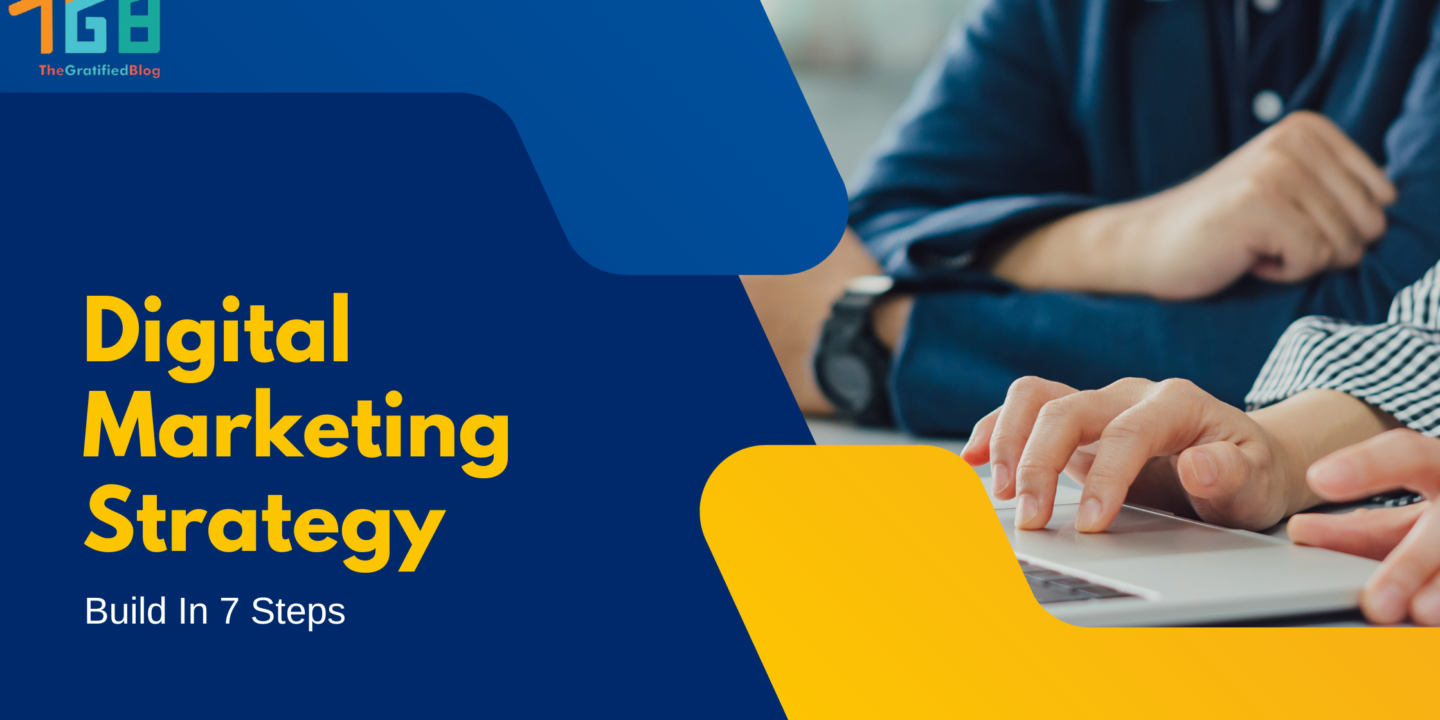
With the changes the business world has witnessed of late, it is no wonder that the digital revolution plays a vital role in marketing success. According to research done in 2020, more than 50% of the world’s population had access to the Internet. That explains why you need a powerful Digital Marketing Strategy to appeal to your potential audience.
Today, you can easily tap into digitization’s numerous opportunities and start reaping the benefits. You must have a practical digital marketing strategy to realize your return on investment.
You’ll be able to reach your potential audience, increase your website traffic, and maximize your conversions. However, lacking a sound strategy will impact your digital marketing success.
With the tide in favor of digitization, you cannot depend on a few blog posts and sporadic social media postings. These are just a fraction of the overall digital marketing efforts. With a clear strategy, you’re confident in brand positioning, eventually leading to brand success.
So, ensure you invest your time and resources to achieve outstanding results. Define your target demographic, corporate goals, and unique value proposition.
Before we dive into effective digital marketing strategies, here are some quick takeaways:
- Focus on valuable tactics and channels that would work best for your brand.
- Approach digital marketing wisely and deliberately for the strategies to work.
- Ensure you optimize and automate to maximize your time and resource usage.
Audit Your Digital Landscape And Its Performance
You need to start with research and analysis for your strategy to be effective. Tidal Digital emphasizes that doing this gives you a clear grasp of the approach you should deploy for your business performance to be optimal. You’ll get to understand your target market and the best way to drive conversions and achieve your ROI. Besides, an in-depth audit helps you understand how you compare to your competition.
- Examine the performance of all your digital presence. How did your content perform over the past years? Does your overall branding and creativity stand out? After analyzing your data, you can gauge what worked and what didn’t. You’ll be able to know if you need to tweak or change your entire branding. Also, this gives you a deeper understanding of why it worked or didn’t work.
- Study your competitors. Set aside time to research the online presence of your brand competitors. What are they doing differently? Understanding what SEO tactics they leverage on their website and social media and how they structure their email marketing campaigns is good.
- Knowing the type of content being prioritized and understanding the engagement of their digital platforms is a bonus plus. Don’t worry. Internet marketing has made it easy for everyone to access this data. This is because all this is available to the public, so keeping up and observing your rivals is simple.
- Familiarize yourself with your clients. You should leverage their free audience insights tool if you have a Facebook presence. It will give you a detailed overview of the size of your audience, activities, demographics, and interests. Also, Google Trends for SEO is another effective and accessible tool for popular search terms. This is essential as it will help you understand how to leverage pay-per-click on all your digital platforms.
Establish Your Marketing Goals

Everyone understands the importance of setting goals to propel the success of their business. However, defining clear objectives and goals takes a lot of work for most people.
The GSOT strategy framework will help simplify your objectives and give you a clear road map for achieving your goals. The GSOT is an acronym for goals, strategies, objectives, and tactics.
Goals
Goals represent your broad and overall objective for your business online or offline. You want to increase your online sales by 15% or get 1000 people to sign up for your upcoming event. Increasing online revenue represents your primary goal.
Strategy
How will you achieve your primary goal of increasing your online revenue? Do you need to run an awareness or engagement campaign? Which marketing campaigns or channels will work for your brand? Once you can answer this, you can narrow it down to specific actions.
Objectives
That represents your measurable figures that relate to your goals. You’ve established you want to increase your online revenue by 15%, so what do you need to do? One immediate goal will be attracting 1000 leads to hit your 15% goal.
Tactics
The tactics you employ should align with your objectives. So, how do you attract 1000 leads? What lead magnet will you use for your digital marketing campaign? It could be offering a free ebook, a webinar, or enticing exclusive offers.
Digital marketing is comprehensive. Setting a clear strategy helps you focus on areas that will drive your business success. The challenge comes in narrowing down an effective action to leverage.
Define Your Target Audience
Digital marketing is different from traditional marketing regarding the target landscape. This is because digital marketing allows you to target specific demographics, unlike conventional marketing.
Start by identifying the demographics you want to attract. That can be easy to determine if you have your primary digital property or website.
You can use analytics reports to establish the kind of customers buying from you. Your website analytical report will define your market by age, gender, profession, geo-location, etc.
You can use a digital marketing agency if you’re just starting your business. They can help you audit your competitors to understand who they’re tailoring their products for.
However, you can still optimize your strategy with your competitor’s clients in mind. Instead, start by niching down your product or service to their potential clients and those they may miss out on.
You can decide to start by aiming at other businesses or consumers. You can tailor your product from business to business to consumer (B2B2C). However, it might be overwhelming to you when starting. That’s why focusing on one market first, instead of everyone, is advisable.
Carefully craft your potential niche market. As a business owner, you need to be part of developing a well-defined audience for digital marketing strategy.
If you don’t have the resources and time, then a digital marketing company may help you survey your present and potential clients, But you can choose to research on your own.
Evaluate And Choose Your Marketing Strategies And Channels

It would be a scam if we told you you must implement all the available digital marketing techniques. Even well-established businesses only apply some tactics in their marketing strategy.
You need to start with a few tactics for online marketing to be effective. Focus all your energy on understanding and mastering the selected strategies before implementing them. That should be fine for you, as there is always room for diversifying the tactics while your web presence grows.
Some of the digital marketing strategies you can leverage include:
- Social media marketing (SMM)
- Search engine optimization (SEO)
- Content marketing
- Search engine marketing (SEM)
- Pay-per-click (PPC)
- Video Marketing
- Email advertising
That is also true when choosing critical channels for your business. Focusing on only the vital social media channels helps you maximize your results.
Avoid expanding your social media presence over many channels. You can start with a few channels that you’re familiar with, like Twitter, Facebook, and Instagram. Your biggest priority is expanding your brand presence on these platforms and utilizing their potential for your business.
Determine Your Content Strategy
After choosing your digital marketing tactics and channels, the next step is building your content strategy. All these platforms need compelling content to be effective for your business.
First, you must start by critically understanding the material that will work for your audience. The content must be effective when addressing their requirements and solving real-life problems. To ace this one, you need to build your audience personas.
Your buyers’ personas will help to guide your content strategy for your digital marketing. You already have products or services that fit your buyers’ personas, So you only need to improve and expand the content to fill any missing gaps.
The two primary goals for your content should be the following:
- To add value to your readers and potential clients.
- To increase your online conversions and sales by creating brand visibility.
But the primary goal for content creation should always be to put your audience’s and clients’ demands at the forefront. If providing value is your top priority, results will trickle down to leads and sales conversion automatically. Content creation services are crucial in executing an effective digital marketing strategy.
Establish An Effective Promotional Strategy

Producing great content is vital in content marketing. However, this content will only be valuable if you have brand visibility. Therefore, you need to promote this content to succeed in digital marketing.
You can use the digital channels mentioned previously and strategize how to increase traffic to your content assets.
Let’s say you’ve published video content or blog posts on your website. You will need to run promotions to increase traffic. You can start by sharing it with your social media audience or include it in your upcoming email newsletter.
The bottom line is to ensure every content receives enough online visibility. You can leverage paid advertising if you want instant results.
Measure And Optimize

Finally, this step is essential for the success of your digital marketing. You need to have a regular plan to assess the effectiveness of your content and campaigns. Ensure you make adjustments where necessary to improve your outcomes.
To improve your digital marketing strategy, you need to keep track of your:
- Website and social media traffic statistics
- The conversion rate statistics of your content
- The engagement statistics of your site’s content
This proven tactic can help you tailor your content for future digital success.
FAQs
Q1. What Is A 360 Digital Marketing Strategy?
A 360-degree digital marketing strategy is an integrated and comprehensive approach that utilizes multiple online marketing channels and tactics to create a seamless and consistent brand experience across all touchpoints.
It incorporates a holistic view of a brand’s online presence and seeks to maximize the effectiveness of marketing efforts by leveraging various digital channels in a coordinated manner. The integration and synergy among various digital marketing components ensure a consistent and compelling brand experience throughout the customer journey.
Q2. What Is The Bidding Strategy In Digital Marketing?
Bidding strategy in digital marketing refers to the approach used to determine the maximum amount an advertiser is willing to pay for ad placements.
It involves setting parameters and tactics to optimize ad performance and achieve marketing goals, such as maximizing return on ad spend (ROAS). That can be done through manual bidding or automated bidding algorithms offered by advertising platforms.
Final Thoughts
With that said, always remember digital marketing trends keep evolving. The strategy that worked for a brand in previous years is different today.
New tactics are continually introduced in the digital marketing realm every year. Therefore, established brands and startups must keep up with the latest trends.
Working with a digital agency helps your brand keep up with all these changes. A digital agency would advise on the most effective digital marketing strategies that would guide your business to success. Otherwise, you will lose a lot of revenue from your competitors.
Also, Read – How To Use Hashtag Marketing Effectively In 2023, and
A Guide To DSP (Demand Side Platform) Marketing








No Comments